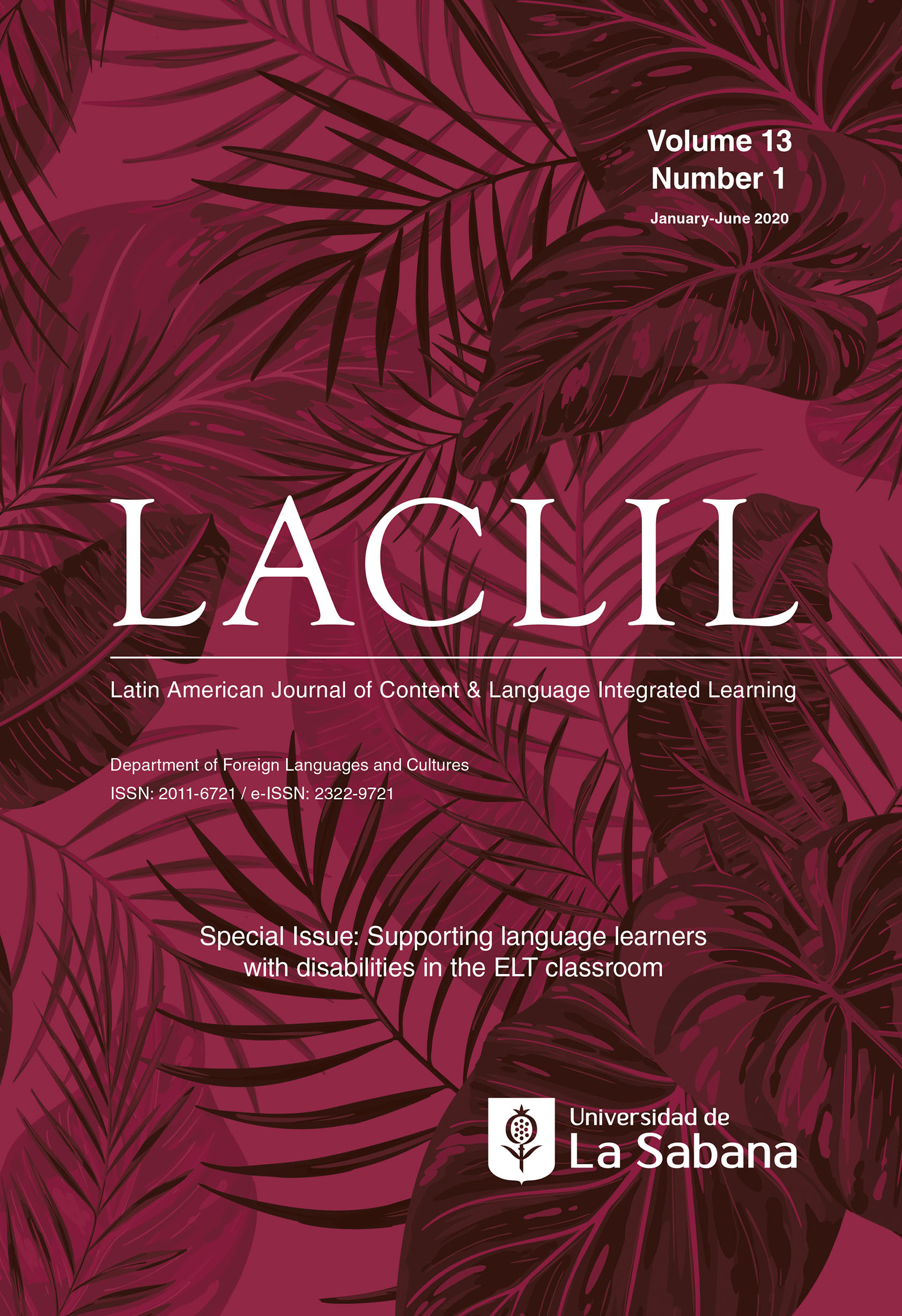Universal Design for Learning in Assessment: Supporting ELLs with Learning Disabilities
DOI:
https://doi.org/10.5294/laclil.2020.13.1.5Keywords:
Learning disabilities, universal design, universal design for learning, UDL, assessment, evaluation, higher education.Abstract
Diseño universal para el aprendizaje en la evaluación: apoyo a los ELL con dificultades de aprendizaje
Design universal para a aprendizagem na avaliação: apoio aos ELLs com dificuldades de aprendizagem
Studying English is challenging and, for many learners, undiagnosed learning disabilities can present a serious threat to their success. Recent studies indicate that up to 10% of the world population has a non-apparent disability, such as autism or dyslexia. At the same time, few English language learner (ELL) instructors in higher education have training in learning disabilities, and they are often unsure of how to support learners who seem to have extra challenges. This is especially true when it comes to assessment, as instructors often rely on traditional tools that could negatively affect the validity of the assessment outcomes. In this brief reflection, the authors share how instructors can apply the principles of Universal Design for Learning (UDL) to their assessment practices to support students with disabilities, regardless of diagnostic status. First, disabilities that affect language learning will be briefly discussed, followed by the explanation of how English to speakers of other languages (ESOL) assessments present specific challenges for students with disabilities. Then, the authors will provide an overview of UDL theory, which proposes that learners with disabilities are often best served by accommodations in representation, expression and engagement that can benefit the entire class. Most of the paper will focus on specific, practical strategies for implementing UDL within assessment in higher education. Such strategies include building executive function, implementing multi-channel assessment, and learning about students through an “evaluation loop.”
To reference this article (APA) / Para citar este artículo (APA) / Para citar este artigo (APA)
Delaney, T. A., & Hata, M. (2020). Universal design for learning in assessment: Supporting ELLs with learning disabilities. Latin American Journal of Content & Language Integrated Learning, 13(1), 79-91. https://doi.org/10.5294/laclil.2020.13.1.5
Received: 16/10/2019
Accepted: 25/02/2020
Published: 28/08/2020
Downloads
References
American Psychiatric Association. (2019a). What is ADHD? https://www.psychiatry.org/patients-families/adhd/what-is-adhd
American Psychiatric Association. (2019b). What is autism spectrum disorder? https://www.psychiatry.org/patients-families/autism/what-is-autism-spectrum-disorder
Brookhart, S. M. (2009). The many meanings of “multiple measures.” Educational Leadership, 67(3), 6–12. http://www.ascd.org/publications/educational-leadership/nov09/vol67/num03/The-Many-Meanings-of-%C2%A3Multiple-Measures%C2%A3.aspx
Butterworth, B., & Kovas, Y. (2013). Understanding neurocognitive developmental disorders can improve education for all. Science, 340(6130), 300–305. https://doi.org/10.1126/science.1231022
Center for Applied Special Technology. (2014). Universal design for learning guidelines version 2.1 [graphic organizer]. http://udlguidelines.cast.org/?utm_medium=web&utm_campaign=none&utm_source=cast-about-udl
Center for Applied Special Technology. (2019). About Universal Design of Learning. http://www.cast.org/our-work/about-udl.html#.XyHq1vhKjfZ
Hughes, A. (2003). Testing for language teachers. Cambridge University Press. Individuals with Disabilities Education Act, 20 U.S.C. § 1400 of 2004.
Japan Student Services Organization. (2015). 平成26年度(2014年度)障害のある学生の修学支援に関する実態調査. https://www.jasso.go.jp/gakusei/tokubetsu_shien/chosa_kenkyu/chosa/2014.html
Larson, K., Russ, S. A., Kahn, R. S., & Halfon, N. (2011). Patterns of comorbidity, functioning, and service use for US children with ADHD, 2007. Pediatrics, 127(3), 462–470. https://doi.org/10.1542/peds.2010-0165
Nakayama W. T., & Butterworth, B. (1999). A case study of an English-Japanese bilingual with monolingual dyslexia. Cognition, 70, 273–305.
National Center for Education Statistics. (2019). Table 6. MAIN TYPE OF CONDITION: Among undergraduates reporting disabilities, percentage distribution of main type of condition or impairment, by selected demographic and enrollment characteristics: 2011–12. https://nces.ed.gov/Datalab/TablesLibrary/TableDetails/11798?rst=true
National Center for Learning Disabilities (NCLD). (2014). The state of learning disabilities: Facts, trends and indicators. NCLD.
Sireci, S. G., Scarpati, S. E., & Li, S. (2005). Test accommodations for students with disabilities: An analysis of the interaction hypothesis. Review of Educational Research, 75(4), 457–490. https://doi.org/10.3102/00346543075004457
Snyder, T. D., Brey, C. d., & Dillow, S. A. (2019). Digest of education statistics, 2017. https://nces.ed.gov/pubs2018/2018070.pdf
The International Dyslexia Association. (2019). Definition of dyslexia. https://dyslexiaida.org/definition-of-dyslexia/
Wesche, M. B. (1983). Communicative testing in a second language. The Modern Language Journal, 67(1), 41–55. https://doi.org/10.2307/326692
Downloads
Published
How to Cite
Issue
Section
License
This Journal and its articles are published under the Creative Commons CC BY 4.0 DEED Attribution 4.0 International license. You are free to: Share — copy and redistribute the material in any medium or format for any purpose, even commercially. Adapt — remix, transform, and build upon the material for any purpose, even commercially. The license cannot revoke these freedoms as long as you follow the terms of the license.








